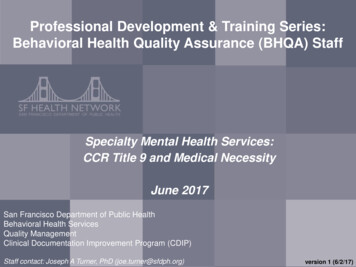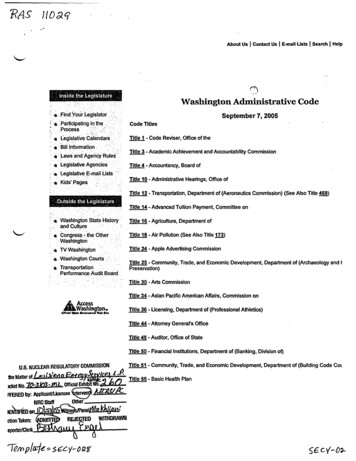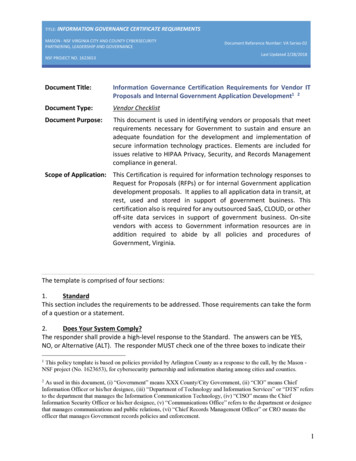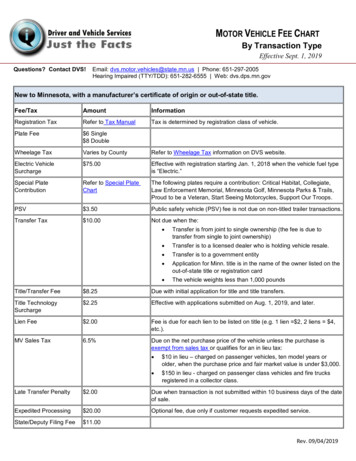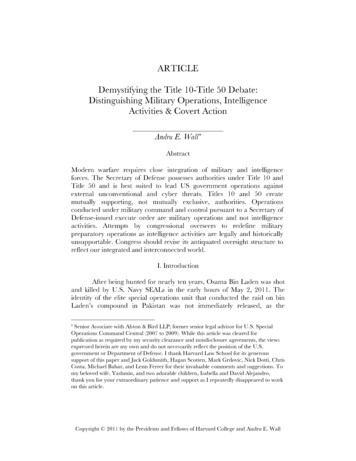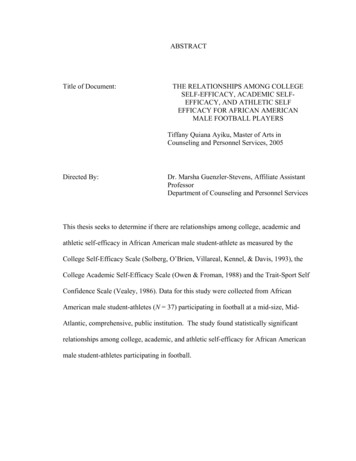
Transcription
ABSTRACTTitle of Document:THE RELATIONSHIPS AMONG COLLEGESELF-EFFICACY, ACADEMIC SELFEFFICACY, AND ATHLETIC SELFEFFICACY FOR AFRICAN AMERICANMALE FOOTBALL PLAYERSTiffany Quiana Ayiku, Master of Arts inCounseling and Personnel Services, 2005Directed By:Dr. Marsha Guenzler-Stevens, Affiliate AssistantProfessorDepartment of Counseling and Personnel ServicesThis thesis seeks to determine if there are relationships among college, academic andathletic self-efficacy in African American male student-athlete as measured by theCollege Self-Efficacy Scale (Solberg, O’Brien, Villareal, Kennel, & Davis, 1993), theCollege Academic Self-Efficacy Scale (Owen & Froman, 1988) and the Trait-Sport SelfConfidence Scale (Vealey, 1986). Data for this study were collected from AfricanAmerican male student-athletes (N 37) participating in football at a mid-size, MidAtlantic, comprehensive, public institution. The study found statistically significantrelationships among college, academic, and athletic self-efficacy for African Americanmale student-athletes participating in football.
THE RELATIONSHIPS AMONG COLLEGE SELF-EFFICACY, ACADEMICSELF-EFFICACY, AND ATHLETIC SELF EFFICACY FOR AFRICAN AMERICANMALE FOOTBALL PLAYERSbyTiffany Quiana AyikuThesis submitted to the Faculty of the Graduate School of theUniversity of Maryland, College Park, in partial fulfillmentof the requirements for the degree ofMaster of Arts2005Advisory Committee:Dr. Marsha Guenzler-Stevens, Affiliate Assistant Professor,ChairDr. Marylu K. McEwen, Associate ProfessorDr. Susan Komives, Associate ProfessorDr. William Sedlacek, ProfessorDr. Javaune Adams-Gaston, Assistant Professor
Copyright byTiffany Q. Ayiku2005
ACKNOWLEDGMENTSI would like to thank a few special people whose support and guidance helped methrough this life-changing process. With their assistance, I am sure that this thesis couldnot have been completed.First, and foremost, I would like to thank God, from whom all blessings flow.Without Him, nothing is possible. I would like to thank my incredible network of familyand friends. Mom, thank you for your love and guidance and for being supportive whenyou didn’t quite get what I was talking about. To the Click, Robin, Angel, and especiallymy sister in the name of love, Tica, thank you for dragging me out of my room onSaturday nights so that I could be reminded that the world exists beyond graduate school.To Mary, thank you for feeding me for the past 14 years and for allowing me to becomepart of your family. To Joan, thank you for being the best supervisor and friend a girlcould hope for. Thank you for all your support and your unique way of showingsympathy. I love you. To Matt, one of the best people I know. Thank you for sharingyour thoughts, stories, and for your support. You have been a wonderful supervisor andfriend.My deepest gratitude goes out to my thesis committee, Dr. Marsha GuenzlerStevens, Dr. Marylu McEwen, Dr. Javaune Adams-Gaston, Dr. William Sedlacek and Dr.Susan Komives. To Marsha, my thesis chair and advisor, thank you for taking me on andkeeping me motivated, grounded and focused. You are truly an angel and I am blessed toknow you and to call you my friend and ally. To Marylu, thank you for all of theteachable moments where you have given me a nugget of wisdom. I cherish therelationship we have built over the past two years and look forward to continuedii
collaboration and quick conversations that mean so much. To Jauvaune, thank you forbeing an inspiration and a role model for young African American women professionalsin student affairs. Thank you for your continued support, wisdom, and insight. To Dr.Sed, thank you for teaching me how to avoid Type I error and for being statisticallysignificant to p .01. To Susan, thank you for bailing us all out in the 11th hour. I amconstantly amazed at all that you do with a cheerful smile and an open heart. You aretruly a gem. Finally, I would like to thank Dr. Karen Kurotsuchi Inkelas. Karen, thankyou for giving me a love for statistics and for teaching me how to create a survey thateven Bubba would fill out. You are amazing!To my Road Dogs: Gina, Paul, Dan, José, Marcus, Greg, Yen Ling, Josh, thankyou all for your love, support, and for the creation of the Thesis Support Group. I amblessed to know you all and words cannot express my gratitude for all that you have donefor me. You all know that if you need me, you have nothing to do but pick up the phone.I’ll be there. I love you all.To my O.F.S.L. family. Thank you for your support duringthe past two years. I am truly thankful to work with a group of people who understandthe needs of students and who truly believe in the importance of Greek Life. Andfinally, to the football coach at the institution of study, thank you for granting me accessto your student-athletes and for being so willing to help me realize my dream.iii
TABLE OF CONTENTSACKNOWLEDGEMENTS.iiTABLE OF CONTENTS.ivLIST OF TABLES.viCHAPTER I .1Introduction.1Self-Efficacy .3Student-Athletes.4African American Males and Athletic Participation.7The Purpose Statement .9Definitions of Terms .9Summary of Methods.12Significance of Study.13Summary .15CHAPTER II.16Self-Efficacy .16Theoretical Framework.16Academic Self-Efficacy .21Athletic Self-Efficacy .24African American Male College Students .27African American Male Student-Athletes .33African American Male Athletes and Academic Achievement.35Summary .40CHAPTER III .42Research Design.42Hypotheses.43Description of Sample.43Instrumentation .44College Self-Efficacy Inventory .44College Academic Self-Efficacy Scale.46Trait-Sport Confidence Inventory.47Data Collection .49Data Analysis .50Summary .51iv
CHAPTER IV .52Sample Characteristics.52Results of the Primary Research Question.54Primary Results.57Summary .60CHAPTER FIVE .61Summary and Discussion of Findings .61Implications for Practice .64Limitations .68Suggestions for Future Research .70Summary .74APPENDIX A: College Self-Efficacy Inventory .76APPENDIX B: College Academic Self-Efficacy Scale .77APPENDIX C: Trait-Sport Confidence Inventory .78APPENDIX D: Demographic Questionnaire.79APPENDIX E: Consent Form for Survey Participants.80APPENDIX F: Instrument Permissions.81REFERENCES .84v
LIST OF TABLES4.1Frequency and Percentages of Positions Played.534.2Hours Per Week Participating in Football .544.3Means, Standard Deviations and Cronbach’s α of Instruments .544.4Qualitative Comments by Respondents .574.5Correlation Matrix for College, Academicand Athletic Self Efficacy.59vi
CHAPTER IINTRODUCTIONThe National Collegiate Athletic Association (NCAA, 2003) published a reportoutlining statistics on the 1997 entering freshmen class at Division I institutions andfound that of the student-athletes who participated in NCAA Division I football, 18%fewer African American male student-athletes graduated from their institution of studythan their White counterparts. When the NCAA compared the graduation rates of allmen participating in Division I intercollegiate athletics, 48% of African American malestudent-athletes graduated as compared to 66% of their White male counterparts, which isconsistent with the graduation rate of African American male football players (NCAA).Student-athletes have a very different college experience from their non-athletecounterparts (Watt & Moore III, 1993). In addition to attending classes, doinghomework, socializing with peers and faculty members, student-athletes must alsopractice and learn game play books while training and performing in their respectiveathletic endeavors. Athletes may face many challenges to success as intercollegiateathletes and as students at institutions of higher learning (Carodine, Almond, & Gratto,2001; Etzel, Ferrante, & Pinkney, 1996; Ferrante & Etzel, 1991; Howard-Hamilton &Sina, 2001). Student-athletes who participate in NCAA Division I revenue generatingsports, namely football and basketball, have additional responsibilities such as practice,meetings, and travel, and difficulties navigating their way successfully through college(Watt & Moore III).1
As colleges and universities seek to holistically develop students, attention needsto be paid to the overall educational experience of student-athletes at institutions ofhigher learning. As student-athletes devote time and attention to athletics, theirdevelopment in other areas, such as artistic, political, and religious, suffers (Astin, 1984).The necessary time devoted to athletics can often leave student-athletes worn out andfeeling isolated from their academic and their non-athletic peers (Adler & Adler, 1984).Bandura (1994) stated that students who feel more confident in specific domainswill seek to improve and master learned skills in specific areas. He framed this conceptof domain specific self-confidence as self-efficacy. Those who have high levels of selfefficacy are more confident that they will be able to accomplish goals in certain areasthan those with low self-efficacy. Research shows that student-athletes spend more timein athletic pursuits than on academic ones (Watts & Moore, III, 1993) and therefore maynot have the time and/or opportunity to develop high levels of self-efficacy in differentdomains. This study seeks to investigate levels of self-efficacy across various domainsfor African American male student-athletes who participate in NCAA Division I football.This chapter will serve to provide an overview of the study including adescription of self-efficacy, student athletes and struggles and challenges that make thema special population at college and universities, and African American males and theirparticipation in intercollegiate athletics. Following the background of the study will be adescription of the purpose of the study, definitions of terms used in the study, a summaryof methodology and the significance of the study, and finally, a summary of participantscovered in chapter one.2
Self-EfficacyPeople are both products and producers of their environment. They are bothinfluenced by and have the ability to influence their environment (Bandura, 1989).Depending on environmental climate, a person may alter his or her behavior to best suitthat environment. Conversely, the environment or climate can be changed by a person’sbehavior (Bandura). Early Social Cognitive Theory placed a large responsibility for thedevelopment of a person on her or his environment (Schunk & Pajares, 2002). Drawingon this theory of social cognition, Bandura and a colleague created a Social LearningTheory that attempted to explain more of how students learn and develop. Schunk andPajares stated that in 1979 Bandura found that a student’s belief in his or her ability toaccomplish tasks and develop competencies was what was missing from developmentaltheories of the past. From this development came the concept of personal self-efficacy.Bandura (1994) contends that a student’s belief in his or her ability to accomplishvarious tasks is highly influential on whether she or he actually accomplishes the task orsucceeds in an individual area. He termed the belief in one’s abilities as personal selfefficacy. Personal self-efficacy is believed to be domain-specific and is developedthroughout a person’s life in four ways: cognitive, modeling, social persuasion and mood(Bandura, 1994, 1997, 2003). Cognitive self-efficacy pertains to aspirations and isdeveloped “by visualizing successful outcomes instead of dwelling on personaldeficiencies or ways in which things might go wrong” (Bandura, 2003, p. 4). Developingthis type of self-efficacy entails successful handling of a crisis or difficult situations. It isless important whether the situation resolves itself favorably, but that the individual wasable to handle the crisis. Adverse situations and threats provide the type of stressful3
situations that students must overcome as they continue to develop the skills necessary tobe successful in a given area. Personally inefficacious students have often made thecommitment to avoid the stress and anxiety associated with performing a difficult task.By doing so, they have eliminated the possibility of failure but also of growth anddevelopment.Modeling behavior or vicarious experiences allow a person to learn from theactions or behaviors of others without first-hand experience. Persuasion refers to aperson being convinced of his or her ability by another person. Finally, a person’s attitudeor mood affects a person’s belief about whether he or she will be able to accomplish atask. All these methods contribute separately and together to an individual’sdevelopment and level of personal self-efficacy (Bandura, 1994, 1997).Student-AthletesStudent-athletes are a population who may experience growth and developmentdifficulties with both cognitive and psychosocial tasks (Carodine, Almond, & Gratto,2001; Parham, 1993). More specifically, Ferrante and Etzel (1991) stated that studentathletes need assistance in overcoming challenges in the development of athletic,academic, and personal skills. Howard-Hamilton and Sina (2001) echoed previousresearchers when they stated that student-athletes need assistance in developing academicand athletic skills; the authors added that student-athletes also need assistance in thedevelopment of appropriate social skills in order to be successful in the college arena andbeyond. Sowa and Gressard (1983) contended that student-athletes may not mature asother students do, due to the nature and culture of large team sports. Developing lifeskills is essential to future success and failure to develop skills in the aforementioned4
areas may lead to dissatisfaction, stress, psychological problems and finally, athleticineligibility (Sowa & Gressard).Student-athletes face many challenges both in the spheres of academia andathletics. Many student-athletes, particularly African American males, come into collegeless academically prepared than their non-athlete counterparts. They often cannotcompete in the classroom with their peers (Edwards, 2000) and consequently have beenfound to have lower standardized test scores and grade point averages than averagecollege students (Hood, Craig, & Ferguson, 1992). On the whole, students whoparticipate in intercollegiate sports have difficulty forming well made educational plansand aspirations (Sowa & Gressard, 1983).Student-athletes’ in-class experiences also challenge their ability to perform inacademic situations. Engstrom, Sedlacek and McEwen (1995) studied faculty attitudestowards male student-athletes. They found that faculty members have prejudices towardsathletes when compared to other students. Faculty felt that athletes possessed lessacademic ability than non students-athletes and expressed anger and discontent insituations where athletes received special services and/or privileges (Engstrom et al.).Faculty members had particularly strong reactions to athletes who were admitted tocolleges with lower SAT scores than non-student athletes and those who received fullscholarships for their athletic abilities.Engstrom et al. postulated that faculty felt thatsome athletes do not deserve to be at the institution. Lastly, Engstrom et al. found thatfaculty members were more apt to be suspicious of an athlete who made an A in a classas compared to non-student athletes. In addition to the energy exerted in a challenging5
classroom environment, athletes must also dedicate a great deal of time and energy totheir respective sport.By the time athletes reach Division I institutions, they have focused significantenergy in perfecting their sport, often to the detriment of their academic endeavors(Edwards, 2000). This dedication to improving and honing athletic skill at the expense ofacademic endeavor has been termed role confusion. Chartrand and Lent (1987) contendedthat role confusion occurs when the demands and expectations of one role supersede, tothe detriment of, the other role. In the end, student-athletes become more committed tothe athletic portion of their lives than to the student portion and thus the student-athletemay neglect his or her studies for the good of the team (Blann, 1985; Watt, & Moore III,2001). This is an area of great concern in the matriculation of student-athletes. In a studyof academic motivations and student-athletes, Simons, Van Rheenen, and Covington(1999) found that athletic commitment was negatively correlated with GPA.Consequently, when accounting for previous schooling, academic ability, and otherfactors, student-athletes who place their athletic above their academic commitments werelikely to have lower GPAs than those who were more able to adequately balance bothrealms of commitment (Simons et al.).The rigorous schedule of student-athletes may also impede their academicsuccess. On average, student-athletes, particularly those in revenue-generating sports,will spend upwards of 20-30 hours per week in practice, traveling, game time, training,receiving care for physical ailments, study hall, and working with tutors (Ferrante, Etzel,& Lantz, 1991; Watt & Moore, III, 1993). Parham (1993) stated that “in season” studentathletes often suffer from acute stress as their schedules and responsibilities are more6
intense than when not in season. Balancing academic with athletic responsibilities isdifficult for most, but especially for those athletes who are academically less preparedthan their counterparts.Athletes’ schedules do not allow much time for studying or other academicpursuits. Terenzini, Pascarella, and Blimling (1996) found that athletes, particularlythose who participate in football and basketball, spent more time socializing with friendsor had fewer teachable moments with faculty and students than the average student.African American Males and Athletic ParticipationTo further narrow the scope of the study, African American male student-athleteswere selected for this study as they may require additional attention given theircircumstances and situations (Ferrante & Etzel, 1996). On average, one in every nineAfrican American students in higher education is a student-athlete. More than half of theaverage intercollegiate football team is comprised of African American players (Person,Benson-Quaziena, & Rogers, 2001). In 2000, 42% of African American males inDivision I sports graduated from college as compared to 57% of their White malecounterparts. In revenue generating sports, 42% of African American males participatingin football graduated as compared with 34% in basketball. Conversely, 60% of Whitefootball players and 52% of White basketball players graduated, respectively (Hyatt,2003).Research has been done on what impact participating in intercollegiate athleticshas on African American male students. In addition to the concerns that apply to nonAfrican American male student-athletes in revenue-generating sports, African Americanmale students must also contend with acculturation stress and social isolation7
(Smallwood, Sowa, & Young, 1991). It has been stated that African American studentsexperience alienation when attending a predominantly White institution (Steward,Jackson, & Jackson, 1990). Steward et al. also concluded that academically successfulAfrican American students tended to be loners on campuses.This isolation could be the result of African Americans having to leave theirhome and their cultures to attend predominantly White institutions (Hawkins, 1999).Smallman, Sowa, and Young (1991) conducted a study on ethnic differences andpsychological responses to stress for student-athletes. African American athletes atpredominantly White institutions reported more negative feelings than their Whitecounterparts after a stressful event. Some of this may be attributed to a cross sectionbetween athletic participation and ethnicity. Smallman et al. contended that experiencingstressful events can cause more turbulence for African American athletes than for Whiteathletes as they may have more to adjust to coming into a predominantly Whiteenvironment. In order to assist African American athletes in their adjustment to campusand the new environment, Smallman et al. suggested that cultural adjustments need to bemade in the institutional culture to allow for the coping mechanisms of AfricanAmericans.Though research has been done on African American male student-athletes inseveral areas, there is a significant gap in empirical data and literature with regards tohow confident or efficacious African American male student-athletes are in their abilityto be successful in various contexts.8
Purpose of the StudyThe purpose of this study was to examine if there is a relationship among thecollege, academic, and athletic self-efficacy of African American male athletes whoparticipate in football at an NCAA Division I university. Feelings of self-efficacy weremeasured in several situational constructs. The respondents were asked to evaluate theirfeelings of self-efficacy as they participated in their designated team sport and as theyparticipated in other aspects of the university environment including the academic, social,community service and residential arenas. The intent of the study was to also determineif there is a relationship among college, academic, and athletic self-efficacy. Examiningfeelings of efficacy is important because the data may provide coaches, academicadvisors and counselors at colleges and universities with information on domain-specificconfidence levels of African American male student-athletes. This knowledge canprovide administrators with the foundation for the development of new interventions andprograms to help African American male student-athletes gain more confidence orefficacy in the functional areas of college.Definitions of TermsBefore progressing further into the research study, it is important to define the useof terms that are essential to the understanding of the information presented. For thepurpose of this study, the following terms will be used: Revenue-generating sports,student-athlete, self-efficacy, self-concept, self-esteem, athletic self-efficacy, academicself-efficacy, and lastly, African American.For the purpose of this study, revenue-generating sports is defined asintercollegiate sports programs that have the potential to produce money to fund the9
athletic program at institutions that have National College Athletic Association DivisionI sports. Revenue-generating sports are also responsible for internally sponsoringscholarships for student-athletes. Sports included in the definition of revenue generatingsports are typically basketball, football, and sometimes baseball. This study focusedsolely on football.The term student-athlete is defined as a male or female student who participatesin intercollegiate athletics at the varsity level at the institution of study. Intramural, clubteam, and recreational sports are not included in this definition (Howard-Hamilton &Watt, 2001).Though self-esteem and self-efficacy have been used interchangeably, they aredifferent constructs that measure different areas of a person’s feelings about oneself.Self-efficacy, personal self-efficacy, perceived self-efficacy, or perceived personal selfefficacy, used interchangeably, refers to a personal judgment one makes about one’scapabilities in a specific area. Self-efficacy does not refer to how much a person likeshim or herself or how much he or she likes the task at hand; rather, self-efficacy isconcerned with how well a person believes he or she will be able to reach a desiredoutcome in a designated area (Bandura, 1997). Self-esteem is used to measure selfevaluation and how an individual feels about him or herself both in given areas andoverall (Bandura). Simply stated, self-efficacy measures how successful an individualwill be at a given task or in a given situation; conversely, self-esteem measures how anindividual will feel about him or herself upon succeeding or failing at a given task. Forthe purpose of this study, the term self-efficacy was used to describe how well an athletebelieves that he can obtain the desired outcome successfully in a designated area.10
Lastly, researchers and readers alike have often confused self-efficacy with selfconcept. It is important to note that self-concept refers to a composite view of one’s selfthat is created through evaluations and direct experience with others and it is measured byasking an individual to rate how much one would apply descriptive statements to oneself(Bandura, 1997). Bandura noted, however, that self-concept can be reflective of personalself-efficacy.Self-efficacy is usually domain specific and may not be transferable to otherareas. Therefore, it is necessary for clarification to define other areas of personal selfefficacy. For the purpose of this study, college self-efficacy refers to an individual’s beliefthat he or she will be able to successfully navigate the college experience. In addition toacademics, it is also concerned with an individual’s belief in his or her capability to besuccessful in social settings and living situations.Athletic or sports self-efficacy refers to the athlete’s belief that he or she will beable to proficiently acquire skills of their position(s) necessary to successfully perform atthe peak of their athletic performance. It is also concerned with an athlete’s belief in hisor her ability to achieve personal and team goals which may include everything frommaking good snap decisions, to successfully performing learned skills under pressure.Academic self-efficacy, according to Chemers, Hu, and Garcia (2001), is theability and confidence of a student to master academic subjects and to “ make greateruse of effective cognitive strategies in learning, manage their time and learningenvironments more effectively and monit [or] and regulat[e] their own effort” (p.55).As with most forms of self-efficacy, academic success improves academic self-efficacy,11
and failures decrease positive feelings of academic self-efficacy (Chemers, Hu, &Garcia).African American, as defined by the United States Census Bureau (2003), is aperson having origins in any of the Black racial groups of Africa. It includes people whoindicate their race as “Black, African Am, or Negro or provide written entries such asAfrican American, Afro-American, Ken
This thesis seeks to determine if there are relationships among college, academic and athletic self-efficacy in African American male student-athlete as measured by the College Self-Efficacy Scale (Solberg, O'Brien, Villareal, Kennel, & Davis, 1993), the College Academic Self-Efficacy Scale (Owen & Froman, 1988) and the Trait-Sport Self



